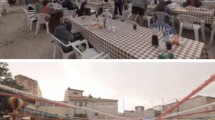Abstract
User experience in virtual environments including presence, enjoyment, and Simulator Sickness (SS) was modeled based on the effects of field-of-view (FOV), stereopsis, visual motion frequency, interactivity, and predictability of motion orientation. We developed an instrument to assess the user experience using multivariate statistics and Item Response Theory. Results indicated that (1) presence was increased with a large FOV, stereo display, visual motion in low frequency ranges (.03 Hz), and high levels of interactivity; (2) more SS was reported with increasing FOV, stereo display, .05-.08 Hz visual motion frequency, lack of interactivity and predictability to visual motion; (3) enjoyment was increased with visual motion in low frequency ranges (.03 Hz) and high levels of interactivity. The resulting response surface model visualizes the complex relationships between presence, enjoyment, and SS. Overall, increasing interactivity was found to be the most profound way to enhance user experience in virtual environments.
Chapter PDF
Similar content being viewed by others
References
Barfield, W., Sheridan, T., Zeltzer, D., Slater, M.: Presence and performance with in virtual environments. In: Barfield, W., Furness, T.A. (eds.) Virtual Environments and Advanced Interface Design, pp. 473–513. Oxford University Press, Oxford (1995)
Witmer, B.G., Singer, M.J.: Measuring presence in virtual environments: a presence questionnaire. Presence: Teleoperators and Virtual Environments 7, 225–240 (1998)
Cobb, S.V.G., Nichols, S., Ramsey, A., Wilson, J.R.: Virtual reality induced symptoms and effects (VRISE). Presence: Teleoperators and Virtual Environments 8, 169–186 (1999)
Kennedy, R.S., Stanney, K.M.: Aftereffects of virtual environment exposure: Psychometric issues. In: Smith, M., Salvendy, G., Koubek, R. (eds.) Design of computing systems: Social and ergonomic considerations, pp. 897–900. Elsevier Science Publishers, Amsterdam (1997)
Reason, J.T., Brand, J.J.: Motion Sickness. Academic Press, London (1975)
Griffin, M.J.: Handbook of Human Vibration. Academic Press, London (1990)
Nichols, S., Haldane, C., Wilson, J.R.: Measurement of presence and its consequences in virtual environments. International Journal of Human-Computer Studies 52, 471–491 (2000)
Nichols, S.: Virtual reality induced symptoms and effects (VRISE): Methodological and theoretical issue. Doctoral thesis, University of Nottingham, Nottingham, U.K (1999)
Plante, T.G., Aldridge, A., Bogden, R., Hanelin, C.: Might virtual reality promote the mood benefits of exercise. Computers in Human Behavior 19, 495–509 (2003)
Lee, F.K., Sheldon, K.M., Turban, D.B.: Personality and the goal-striving process: The influence of achievement goal patterns, goal level, and mental focus on performance and enjoyment. Journal of Applied Psychology 88, 256–265 (2003)
Kennedy, R.S., Lane, N., Berbaum, K., Lilienthal, M.: Simulator sickness questionnaire: an enhanced method for quantifying simulator sickness. International Journal of Aviation Psychology 3, 203–220 (1993)
Kim, D.H.: Development of method for quantification and analysis of simulator sickness in a driving simulation environment. Doctoral dissertation, Hanyang University, Seoul, South Korea (1999)
Singer, M.J., Witmer, B.G.: Presence measures for virtual environments: Background & development. Draft ARI Research Note, U.S. Army Research Institute for the Behavioral and Social Sciences, Alexandria, VA (1996)
Slater, M., Usoh, M., Steed, A.: Depth of presence in virtual environments. Presence: Teleoperators and Virtual Environments 3, 130–144 (1994)
Usoh, M., Catena, E., Arman, S., Slater, M.: Using Presence Questionnaires in Reality. Presence: Teleoperators and Virtual Environment 9, 497–503 (2000)
Lin, J.J.W., Duh, H.B.L., Parker, D.E., Abi-Rached, H., Furness, T.A.: Effects of Field of View on Presence, Enjoyment, Memory, and Simulator Sickness in a Virtual Environment. In: Proceedings of IEEE Virtual Reality 2002, pp. 164–171 (2002)
Lin, J.J.W.: Enhancement of User-Experiences in Virtual Environments that Employ Wide-Field Displays. Dissertation for Doctor of Philosophy, University of Washington, Seattle, USA (2004)
Lin, J.J.W., Razzaque, S., Parker, D.E.: Effects of Simulated Motion Frequency in Virtual Environments. In: Proceedings of the International Conference on Theoretical Issues in Ergonomics Science (TIES 2005) (2005)
Lin, J.J.W., Parker, D.E., Lahav, M., Furness, T.A.: Unobtrusive Turns Prediction Cues Reduced Simulator Sickness during Passive Motion in a Driving Simulator. Ergonomics 48, 608–624 (2005)
Lin, J.J.W., Abi-Rached, H., Lahav, M.: Virtual Guiding Avatar: An Effective Procedure to Reduce Simulator Sickness in Virtual Environments. In: Proceedings of ACM SIGCHI, 719–726 (2004)
Author information
Authors and Affiliations
Editor information
Rights and permissions
Copyright information
© 2007 Springer-Verlag Berlin Heidelberg
About this paper
Cite this paper
Lin, J.J.W., Parker, D.E. (2007). User Experience Modeling and Enhancement for Virtual Environments That Employ Wide-Field Displays. In: Duffy, V.G. (eds) Digital Human Modeling. ICDHM 2007. Lecture Notes in Computer Science, vol 4561. Springer, Berlin, Heidelberg. https://doi.org/10.1007/978-3-540-73321-8_49
Download citation
DOI: https://doi.org/10.1007/978-3-540-73321-8_49
Publisher Name: Springer, Berlin, Heidelberg
Print ISBN: 978-3-540-73318-8
Online ISBN: 978-3-540-73321-8
eBook Packages: Computer ScienceComputer Science (R0)




